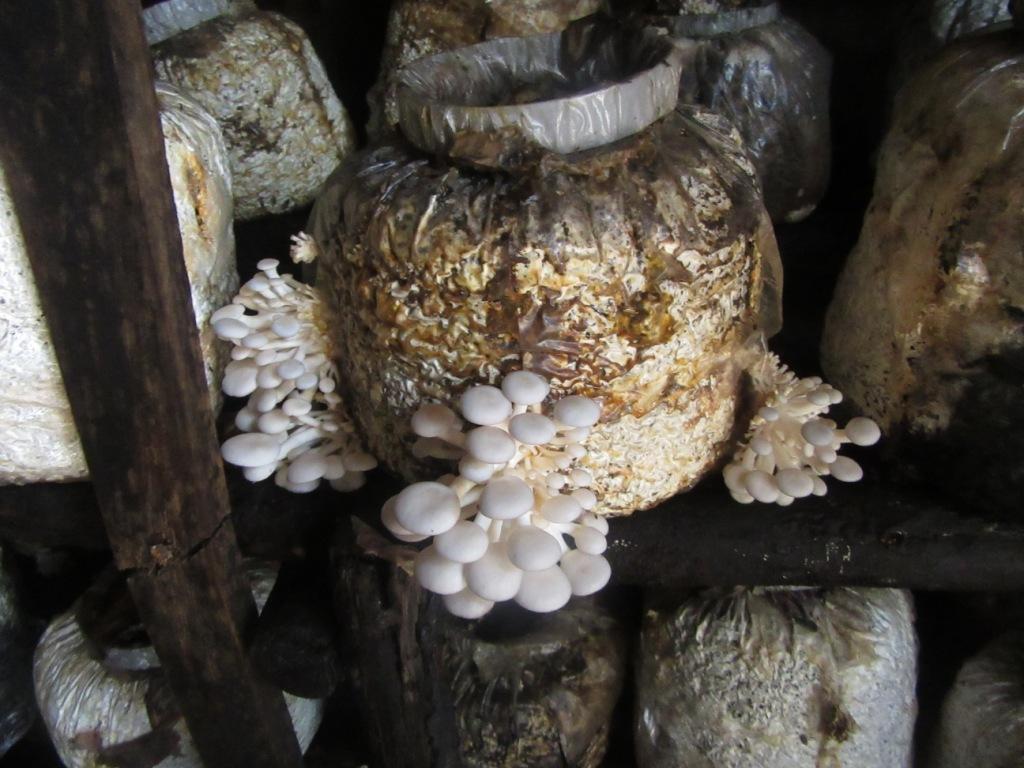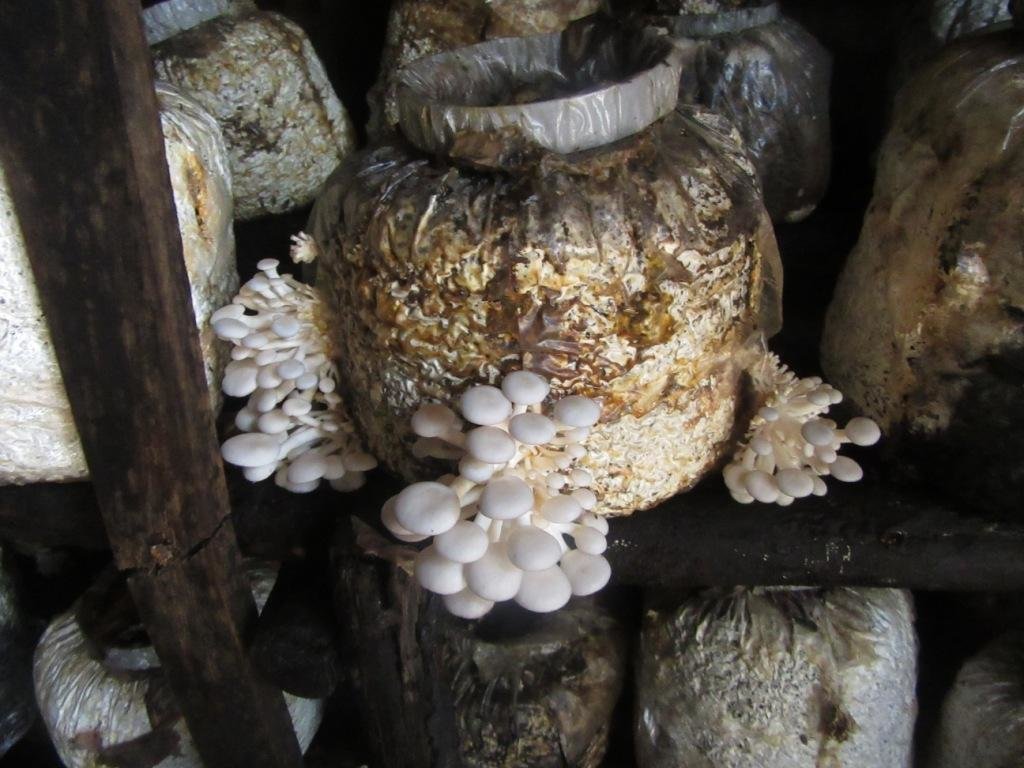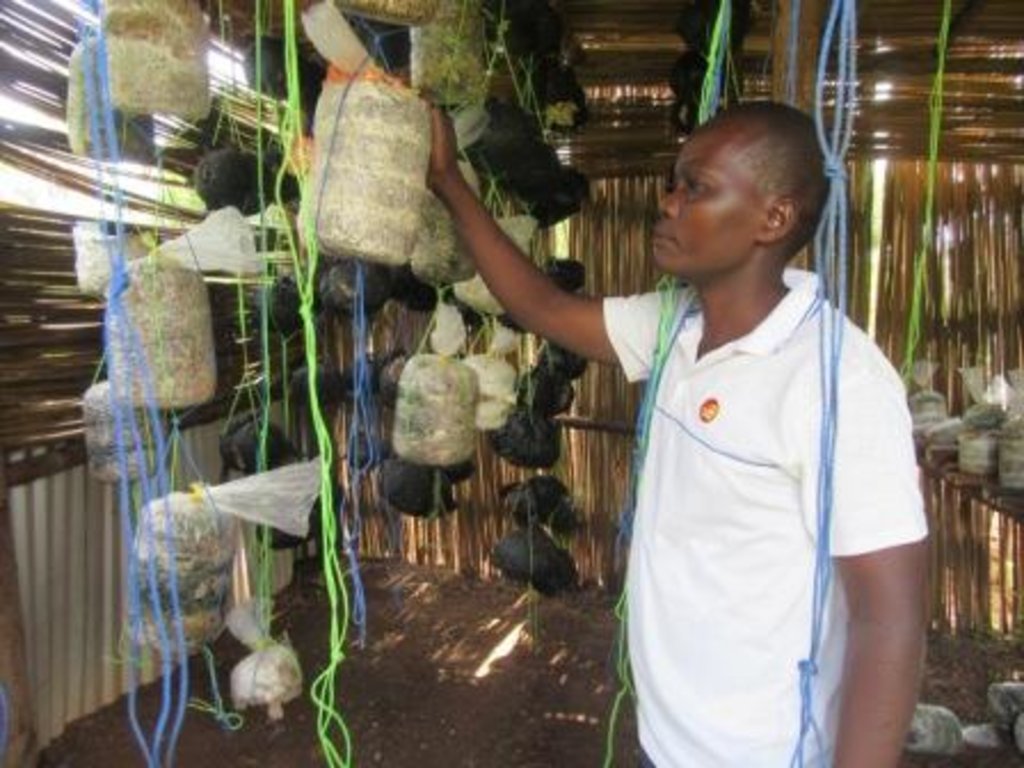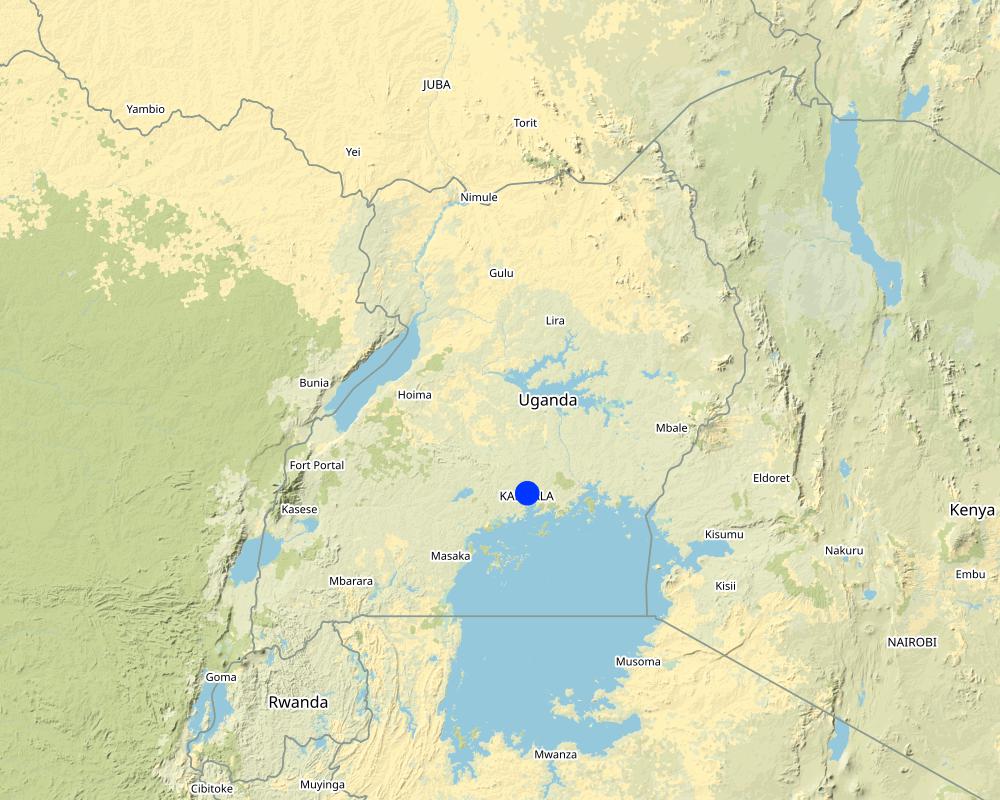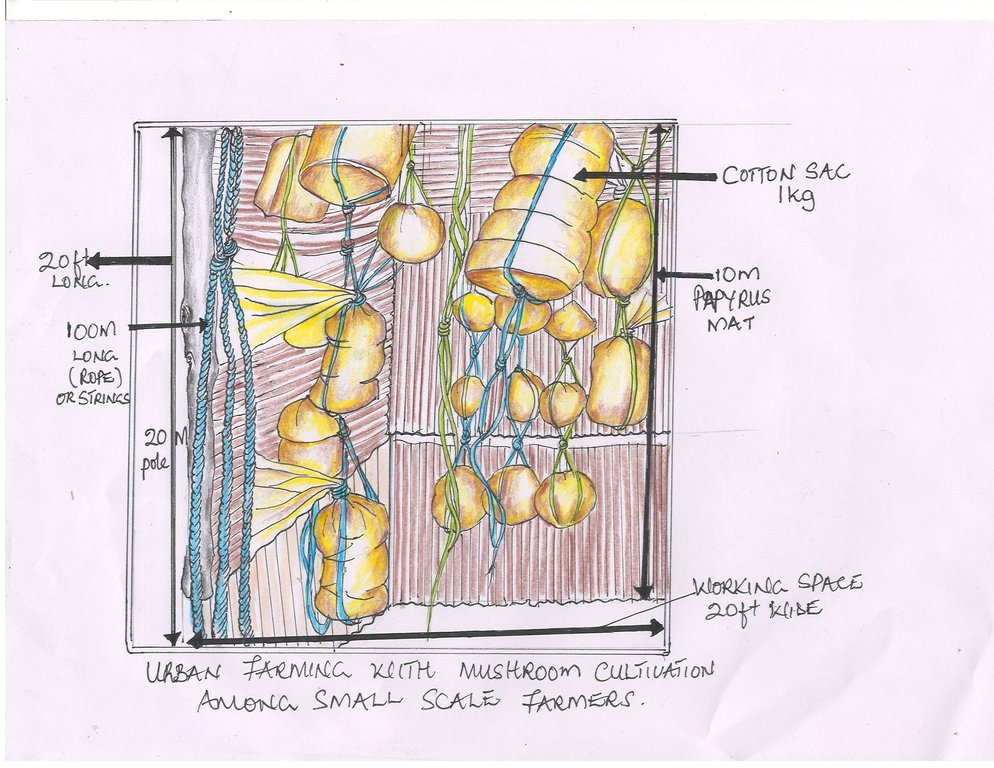Urban Farming with Mushroom Cultivation among Smallholder Farmers. [ยูกันดา]
- ผู้สร้างสรรค์:
- การอัพเดท:
- ผู้รวบรวม: Sarah Babirye
- ผู้เรียบเรียง: Jalia Namakula, Kamugisha Rick Nelson
- ผู้ตรวจสอบ: Nicole Harari, Udo Höggel
Okulima obutiko
technologies_3450 - ยูกันดา
ดูส่วนย่อย
ขยายทั้งหมด ย่อทั้งหมด1. ข้อมูลทั่วไป
1.2 รายละเอียดที่ติดต่อได้ของผู้รวบรวมและองค์กรที่เกี่ยวข้องในการประเมินและการจัดเตรียมทำเอกสารของเทคโนโลยี
วิทยากรหลัก
ผู้ใช้ที่ดิน:
Grace Komuhangi
0782524325
Kamyokya farmers group
Kamyokya, Kisenyi Kampala
ยูกันดา
ชื่อของโครงการซึ่งอำนวยความสะดวกในการทำเอกสารหรือการประเมินเทคโนโลยี (ถ้าเกี่ยวข้อง)
Scaling-up SLM practices by smallholder farmers (IFAD)ชื่อขององค์กรซึ่งอำนวยความสะดวกในการทำเอกสารหรือการประเมินเทคโนโลยี (ถ้าเกี่ยวข้อง)
National Agricultural Research Organisation (NARO) - ยูกันดา1.3 เงื่อนไขการใช้ข้อมูลที่ได้บันทึกผ่านทาง WOCAT
วันที่เก็บรวบรวมข้อมูล(ภาคสนาม) :
12/5/2017
ผู้รวบรวมและวิทยากรหลักยอมรับเงื่อนไขเกี่ยวกับการใช้ข้อมูลที่ถูกบันทึกผ่านทาง WOCAT:
ใช่
1.4 การเปิดเผยเรื่องความยั่งยืนของเทคโนโลยีที่ได้อธิบายไว้
เทคโนโลยีที่ได้อธิบายไว้นี้เป็นปัญหาของความเสื่อมโทรมโทรมของที่ดินหรือไม่ จึงไม่ได้รับการยอมรับว่าเป็นเทคโนโลยีเพื่อการจัดการที่ดินอย่างยั่งยืน:
ไม่ใช่
แสดงความคิดเห็น:
The technology is not problematic with regard to land degradation.
2. การอธิบายลักษณะของเทคโนโลยี SLM
2.1 การอธิบายแบบสั้น ๆ ของเทคโนโลยี
คำจำกัดความของเทคโนโลยี:
Mushroom (agaricus bisporus) cultivation is one of the profitable technologies promoted by small and medium scale farmers in urban setting fetching good returns on investment within a period of 30 days with the aim of obtaining tremendous nutritional benefits, employment and additional income gained by both farmers and suppliers of raw materials thus supporting the local economy and contributing to subsistence food security.
2.2 การอธิบายแบบละเอียดของเทคโนโลยี
คำอธิบาย:
Mushroom cultivation is a preferred and promoted technology by small and medium scale farmers with less land holdings. The technology has the portential to generate considerable nutritional benefits, employment and additional income which, in return, is invested in sustainable land management practices. To date, the demand for mushrooms increases as the result of a fast population growth having less income and food supply. Hence, a growing number of farmers adopt the mushroom production technology.
To establish such a technology, materials required include: cotton, a metallic drum (100 litres), a gunny bag of the size of 100kg, water, tarpuline, lime/maize brand, polyethene bags, banana leaf stock, cooking stove, firewood, mushroom seeds, tooth picks/nails and strings of approx. 100m length.
Listed below are the activities / procedures required for the establishment of a mushroom cultivation in a homestead.
-Water-soak the cotton into the drum and cover the drum with a gunny bag
-Remove the water out of the drum. The soaked cotton remains in the drum for around 2 hours
-Remove the soaked cotton on to a taurpline sheet and mix it with cultural lime/rice brand /maze brand that is placed on the taurpline
-Get black polythene bags and pack 1 kg of cotton into each polythene bag
-Place the banana leaf stock at the bottom of the drum and fill it with 20 litres of water
-Cut the gunny bag in the middle and cover the inside part of the drum to prevent burning of the cotton in the polythene bags while boiling
-Place the cotton in polythene bags into the drum and put the drum on the cooking stove to heat. The first line of polythene bags should be bent to prevent boiling water to enter the cotton
-Cover the drum tight with gunny bags
-Steam for around 2 hours
-Remove the firewood to cool until the next day
-Then remove the cooled cotton and place it on the tarpuline
-Buy mushroom seeds, smash the seeds (i.e, one pack of seeds mixes 2 gardens)
-Each kg of cotton mixed containing the mushroom seeds should be squeezed into the black polythene bags in a ball shape and tied on top
-Then get a tooth pick or a nail and pinch down 3 to 4 holes for air to come out
-Tie strings to the packed polythene bags and hang them for 14 days. (Strings enable sprouting on the gardens from all sides). Having moderate light, water needs to be applied twice a day or thrice in case of dry season during a period of 3 weeks
-After 7 days, the mushrooms start sprouting
-Leave the mushroom on the garden for 2-3 days before harvesting
-Once mushrooms are ripe, get a sharp knife and cut the stem carefully
On harvesting, the first week yields 8 Kg every second day, thereafter 3 kg of mushrooms every second day during the second month. Drums can be replaced every after 4 months so that the cost of maintenance is kept relatively low.
Mushrooms are a source of nutrients and proteins (Protein content, 3-7% when fresh and 25- 40% when dry). They are useful in preventing diseases and have medicinal values. Environmentally, the growing of mushrooms reduces pollution through bio-conservation and improves on crop production since harvested manure from the used mushroom ‘garden’ can be recycled as fertilizers for vegetable gardens at homes.
Despite the advantages, the technology faces various challenges: These include lack of a workplace (physical facility), lack of finance and skills on hygiene and sterilization, compost preparation, market challenges that include instability and decrease in sales prices of the products and inputs. Environmental factors like humidity, Ph, light and ventilation if not controlled may influence the growing process. Insects, diseases and animals due to the enclosed environment in which the mushrooms grow are a high risk. This may result in disease infestations like snails infestation.
However, maintenance costs of this technology are cheaper compared to establishment costs with minimum costs required for replacing worn out poles, replacing drums which can be at least every after 5 months.
2.3 รูปภาพของเทคโนโลยี
2.4 วีดีโอของเทคโนโลยี
สถานที่:
Kamwokya, Kisenyi/Kampala
ชื่อผู้ถ่ายวีดีโอ:
Babirye Sarah
2.5 ประเทศภูมิภาค หรือสถานที่ตั้งที่เทคโนโลยีได้นำไปใช้และได้รับการครอบคลุมโดยการประเมินนี้
ประเทศ:
ยูกันดา
ภูมิภาค/รัฐ/จังหวัด:
Kampala
ข้อมูลจำเพาะเพิ่มเติมของสถานที่ตั้ง :
Kamwokya, Kisenyi
Map
×2.6 วันที่การดำเนินการ
ถ้าไม่รู้ปีที่แน่นอน ให้ระบุวันที่โดยประมาณ:
- น้อยกว่า 10 ปี (ไม่นานนี้)
2.7 คำแนะนำของเทคโนโลยี
- A friend
ความคิดเห็น (ประเภทของโครงการ เป็นต้น) :
Manure harvested from used up mushroom gardens is used as fertilizers in vegetable gardens.
3. การจัดประเภทของเทคโนโลยี SLM
3.1 วัตถุประสงค์หลักของเทคโนโลยี
- ปรับปรุงการผลิตให้ดีขึ้น
- สร้างผลกระทบทางด้านเศรษฐกิจที่เป็นประโยชน์
- สร้างผลกระทบทางด้านสังคมที่เป็นประโยชน์
3.2 ประเภทของการใช้ที่ดินในปัจจุบันที่ได้นำเทคโนโลยีไปใช้

การตั้งถิ่นฐาน โครงสร้างพื้นฐาน
- การตั้งถิ่นฐาน ตึกอาคาร
3.3 ข้อมูลเพิ่มเติมเกี่ยวกับการใช้ที่ดิน
แสดงความคิดเห็น:
The technology is practiced in buildings hence it doesn't require water from the rain or any irrigation source.
จำนวนของฤดูเพาะปลูกต่อปี:
- 1
ระบุ:
Once a month, so 12 seasons in a year
3.4 กลุ่ม SLM ที่ตรงกับเทคโนโลยีนี้
- สวนครัว
3.5 กระจายตัวของเทคโนโลยี
ระบุการกระจายตัวของเทคโนโลยี:
- ใช้ ณ จุดที่เฉพาะเจาะจงหรือเน้นไปยังบริเวณพื้นที่ขนาดเล็ก
แสดงความคิดเห็น:
Mushroom are grown on a small area.
3.6 มาตรการ SLM ที่ประกอบกันเป็นเทคโนโลยี

มาตรการอื่น ๆ
แสดงความคิดเห็น:
Indoor mushroom cultivation. Residues from the gardens on which mushrooms grow can be recycled for fertilizers which can later be applied onto lands or homestead gardens to improve on soil fertility.
3.7 รูปแบบหลักของการเสื่อมโทรมของที่ดินที่ได้รับการแก้ไขโดยเทคโนโลยี

อื่น ๆ
3.8 การป้องกัน การลดลง หรือการฟื้นฟูความเสื่อมโทรมของที่ดิน
ระบุเป้าหมายของเทคโนโลยีกับความเสื่อมโทรมของที่ดิน:
- ไม่สามารถใช้ได้
4. ข้อมูลจำเพาะด้านเทคนิค กิจกรรมการนำไปปฏิบัติใช้ ปัจจัยนำเข้า และค่าใช้จ่าย
4.1 แบบแปลนทางเทคนิคของเทคโนโลยี
4.2 ข้อมูลจำเพาะด้านเทคนิคและการอธิบายแบบแปลนทางเทคนิค
The technical drawing shows the mushroom technology with the following dimensions and inputs required for establishment; a working place (room) of 20 feet long *20 feet wide
One timber of 10 m long length, one tarpaulin of 20 m length *20 m width, strings/ropes of 100m length in total, 10m papyrus mats (2) , polythene bags (of 1 kg ), nails (2 kgs), one drum and 5 bags of cement and 20 gardens.
4.3 ข้อมูลทั่วไปเกี่ยวกับการคำนวณปัจจัยนำเข้าและค่าใช้จ่าย
ให้ระบุว่าค่าใช้จ่ายและปัจจัยนำเข้าได้รับการคำนวณอย่างไร:
- ต่อหน่วยเทคโนโลยี
โปรดระบุหน่วย:
A mushroom growing hut containing a number of mushroom gardens
ระบุปริมาตร ความยาว เป็นต้น (ถ้าเกี่ยวข้อง):
20feet long *20feet wide for a room where mushrooms are grown as shown in the picture
อื่นๆ หรือสกุลเงินประจำชาติ (ระบุ):
Uganda shillings
ระบุอัตราแลกเปลี่ยนจากดอลลาร์สหรัฐเป็นสกุลเงินท้องถิ่น (ถ้าเกี่ยวข้อง) คือ 1 เหรียญสหรัฐ =:
3600.0
ระบุค่าเฉลี่ยของค่าจ้างในการจ้างแรงงานต่อวัน:
3000/= per day
4.4 กิจกรรมเพื่อการจัดตั้ง
| กิจกรรม | ประเภทของมาตรการ | ช่วงเวลาดำเนินการ | |
|---|---|---|---|
| 1. | Construction of a room of approximately 20*20feet | ด้วยโครงสร้าง | Once through out the buisness enterprise |
| 2. | Buying equipments like drum,cotton,garden,jerricans,tarpauline,polythen bags | ด้วยโครงสร้าง | Once through out the business enterprise |
| 3. | Hanging strings in the structure | ด้วยโครงสร้าง | Once through out the busness enterprise |
แสดงความคิดเห็น:
Most of the activities for mushroom growing are cost effective. This is because these items and activities are done once on commencement.
4.5 ค่าใช้จ่ายของปัจจัยนำเข้าที่จำเป็นสำหรับการจัดตั้ง
| ปัจจัยนำเข้า | หน่วย | ปริมาณ | ค่าใช้จ่ายต่อหน่วย | ค่าใช้จ่ายทั้งหมดต่อปัจจัยนำเข้า | %ของค่าใช้จ่ายที่ก่อให้เกิดขึ้นโดยผู้ใช้ที่ดิน | |
|---|---|---|---|---|---|---|
| แรงงาน | Making a structure | Man day | 1.0 | 30000.0 | 30000.0 | 100.0 |
| แรงงาน | Hanging strings | Man day | 1.0 | 10000.0 | 10000.0 | 100.0 |
| อุปกรณ์ | Drum | piece | 1.0 | 50000.0 | 50000.0 | 100.0 |
| อุปกรณ์ | Cotton | piece | 2.0 | 25000.0 | 50000.0 | 100.0 |
| อุปกรณ์ | Polythen bags | piece | 2.0 | 3000.0 | 6000.0 | 100.0 |
| อุปกรณ์ | Jerricans | piece | 4.0 | 5000.0 | 20000.0 | 100.0 |
| วัสดุสำหรับก่อสร้าง | Strings | piece | 5.0 | 3000.0 | 15000.0 | 100.0 |
| วัสดุสำหรับก่อสร้าง | Poles | piece | 20.0 | 3000.0 | 60000.0 | 100.0 |
| วัสดุสำหรับก่อสร้าง | Nails | Kg | 3.0 | 5000.0 | 15000.0 | 100.0 |
| วัสดุสำหรับก่อสร้าง | Papyrus mats | piece | 10.0 | 7000.0 | 70000.0 | 100.0 |
| อื่น ๆ | Tarpuline | piece | 1.0 | 20000.0 | 20000.0 | 100.0 |
| อื่น ๆ | Seed packs | piece | 50.0 | 2000.0 | 100000.0 | 100.0 |
| อื่น ๆ | Maize brand | Kg | 10.0 | 1000.0 | 10000.0 | 100.0 |
| อื่น ๆ | Cultural lime | Kg | 1.0 | 15000.0 | 15000.0 | 100.0 |
| อื่น ๆ | Water | piece | 10.0 | 300.0 | 3000.0 | 100.0 |
| อื่น ๆ | Firewood | piece | 5.0 | 2000.0 | 10000.0 | 100.0 |
| ค่าใช้จ่ายทั้งหมดของการจัดตั้งเทคโนโลยี | 484000.0 | |||||
ถ้าผู้ใช้ที่ดินรับภาระน้อยกว่า 100% ของค่าใช้จ่าย ให้ระบุว่าใครเป็นผู้รับผิดชอบส่วนที่เหลือ:
National Agriculrueal Advisory Services (NAAD supported her with the drum).
แสดงความคิดเห็น:
The initial cost is relatively high for low income farmers although most acquire loans through farmer groups.
4.6 การบำรุงรักษาสภาพหรือกิจกรรมที่เกิดขึ้นเป็นประจำ
| กิจกรรม | ประเภทของมาตรการ | ช่วงระยะเวลา/ความถี่ | |
|---|---|---|---|
| 1. | Replace worn out poles | ด้วยการจัดการ | Once a year |
| 2. | Replace old drums | มาตรการอื่น ๆ | Once a year |
| 3. | Remove infestations by spraying snails | จัดการพืช | Once a year |
| 4. | Cleaning in the growing room | มาตรการอื่น ๆ | Once a year |
แสดงความคิดเห็น:
Most maintaince activities are not frequently made.
4.7 ค่าใช้จ่ายของปัจจัยนำเข้าและกิจกรรมที่เกิดขึ้นเป็นประจำที่ต้องการการบำรุงรักษา (ต่อปี)
| ปัจจัยนำเข้า | หน่วย | ปริมาณ | ค่าใช้จ่ายต่อหน่วย | ค่าใช้จ่ายทั้งหมดต่อปัจจัยนำเข้า | %ของค่าใช้จ่ายที่ก่อให้เกิดขึ้นโดยผู้ใช้ที่ดิน | |
|---|---|---|---|---|---|---|
| อุปกรณ์ | Replace old poles | piece | 10.0 | 3000.0 | 30000.0 | 100.0 |
| อุปกรณ์ | Replace old drums | piece | 50000.0 | 1.0 | 50000.0 | 100.0 |
| อุปกรณ์ | Spray snails | man hour | 3000.0 | 1.0 | 3000.0 | 100.0 |
| อุปกรณ์ | Cleaning the room in which mushrooms grow on their gardens | man hour | 5000.0 | 1.0 | 5000.0 | 100.0 |
| ค่าใช้จ่ายทั้งหมดของการบำรุงรักษาสภาพเทคโนโลยี | 88000.0 | |||||
ถ้าผู้ใช้ที่ดินรับภาระน้อยกว่า 100% ของค่าใช้จ่าย ให้ระบุว่าใครเป็นผู้รับผิดชอบส่วนที่เหลือ:
All costs are met by the farmer.
แสดงความคิดเห็น:
Maintenance costs are less because items are replaced once in a year. This makes the technology cost-efficient.
5. สิ่งแวดล้อมทางธรรมชาติและของมนุษย์
5.1 ภูมิอากาศ
ฝนประจำปี
- < 250 ม.ม.
- 251-500 ม.ม.
- 501-750 ม.ม.
- 751-1,000 ม.ม.
- 1,001-1,500 ม.ม.
- 1,501-2,000 ม.ม.
- 2,001-3,000 ม.ม.
- 3,001-4,000 ม.ม.
- > 4,000 ม.ม.
ระบุปริมาณน้ำฝนเฉลี่ยรายปี (ถ้ารู้) :หน่วย ม.ม.
1500.00
เขตภูมิอากาศเกษตร
- ชื้น
5.2 สภาพภูมิประเทศ
ค่าเฉลี่ยความลาดชัน:
- ราบเรียบ (0-2%)
- ลาดที่ไม่ชัน (3-5%)
- ปานกลาง (6-10%)
- เป็นลูกคลื่น (11-15%)
- เป็นเนิน (16-30%)
- ชัน (31-60%)
- ชันมาก (>60%)
ธรณีสัณฐาน:
- ที่ราบสูง/ที่ราบ
- สันเขา
- ไหล่เขา
- ไหล่เนินเขา
- ตีนเนิน
- หุบเขา
ระดับความสูง:
- 0-100 เมตร
- 101-500 เมตร
- 501-1,000 เมตร
- 1,001-1,500 เมตร
- 1,501-2,000 เมตร
- 2,001-2,500 เมตร
- 2,501-3,000 เมตร
- 3,001-4,000 เมตร
- > 4,000 เมตร
ให้ระบุถ้าเทคโนโลยีได้ถูกนำไปใช้:
- ไม่เกี่ยวข้อง
5.3 ดิน
ค่าเฉลี่ยความลึกของดิน:
- ตื้นมาก (0-20 ซ.ม.)
- ตื้น (21-50 ซ.ม.)
- ลึกปานกลาง (51-80 ซ.ม.)
- ลึก (81-120 ซ.ม.)
- ลึกมาก (>120 ซ.ม.)
เนื้อดิน (ดินชั้นบน):
- ปานกลาง (ดินร่วน ทรายแป้ง)
เนื้อดินล่าง (> 20 ซ.ม.ต่ำจากผิวดิน):
- ปานกลาง (ดินร่วน ทรายแป้ง)
อินทรียวัตถุในดิน:
- ปานกลาง (1-3%)
5.4 ความเป็นประโยชน์และคุณภาพของน้ำ
ระดับน้ำใต้ดิน:
<5 เมตร
น้ำไหลบ่าที่ผิวดิน:
ดี
คุณภาพน้ำ (ที่ยังไม่ได้บำบัด):
เป็นน้ำเพื่อการดื่มที่ดี
ความเค็มของน้ำเป็นปัญหาหรือไม่:
ไม่ใช่
กำลังเกิดน้ำท่วมในพื้นที่หรือไม่:
ไม่ใช่
5.5 ความหลากหลายทางชีวภาพ
ความหลากหลายทางชนิดพันธุ์:
- ปานกลาง
ความหลากหลายของแหล่งที่อยู่:
- ปานกลาง
5.6 ลักษณะของผู้ใช้ที่ดินที่นำเทคโนโลยีไปปฏิบัติใช้
อยู่กับที่หรือเร่ร่อน:
- อยู่กับที่
แนวทางการตลาดของระบบการผลิต:
- ผสม (การเลี้ยงชีพ/ทำการค้า)
รายได้ที่มาจากนอกฟาร์ม:
- 10-50% ของรายได้ทั้งหมด
ระดับของความมั่งคั่งโดยเปรียบเทียบ:
- จน
เป็นรายบุคคล/ครัวเรือน:
- เป็นรายบุคคล/ครัวเรือน
ระดับของการใช้เครื่องจักรกล:
- งานที่ใช้แรงกาย
เพศ:
- หญิง
อายุของผู้ใช้ที่ดิน:
- ผู้สูงอายุ
5.7 พื้นที่เฉลี่ยของที่ดินที่เป็นเจ้าของหรือเช่าโดยผู้ใช้ที่ดินที่นำเทคโนโลยีไปปฏิบัติใช้
- < 0.5 เฮกตาร์
- 0.5-1 เฮกตาร์
- 1-2 เฮกตาร์
- 2-5 เฮกตาร์
- 5-15 เฮกตาร์
- 15-50 เฮกตาร์
- 50-100 เฮกตาร์
- 100-500 เฮกตาร์
- 500-1,000 เฮกตาร์
- 1,000-10,000 เฮกตาร์
- >10,000 เฮกตาร์
พิจารณาว่าเป็นขนาดเล็ก กลาง หรือขนาดใหญ่ (ซึ่งอ้างอิงถึงบริบทระดับท้องถิ่น):
- ขนาดเล็ก
5.8 กรรมสิทธิ์ในที่ดิน สิทธิในการใช้ที่ดินและสิทธิในการใช้น้ำ
กรรมสิทธิ์ในที่ดิน:
- รายบุคคล ไม่ได้รับสิทธิครอบครอง
สิทธิในการใช้ที่ดิน:
- รายบุคคล
สิทธิในการใช้น้ำ:
- รายบุคคล
5.9 การเข้าถึงบริการและโครงสร้างพื้นฐาน
สุขภาพ:
- จน
- ปานกลาง
- ดี
การศึกษา:
- จน
- ปานกลาง
- ดี
ความช่วยเหลือทางด้านเทคนิค:
- จน
- ปานกลาง
- ดี
การจ้างงาน (เช่น ภายนอกฟาร์ม):
- จน
- ปานกลาง
- ดี
ตลาด:
- จน
- ปานกลาง
- ดี
พลังงาน:
- จน
- ปานกลาง
- ดี
ถนนและการขนส่ง:
- จน
- ปานกลาง
- ดี
น้ำดื่มและการสุขาภิบาล:
- จน
- ปานกลาง
- ดี
บริการด้านการเงิน:
- จน
- ปานกลาง
- ดี
6. ผลกระทบและสรุปคำบอกกล่าว
6.1 ผลกระทบในพื้นที่ดำเนินการ (On-site) จากการใช้เทคโนโลยี
ผลกระทบทางด้านเศรษฐกิจและสังคม
การผลิต
การผลิตพืชผล
การจัดการที่ดิน
รายได้และค่าใช้จ่าย
ความหลากหลายของแหล่งผลิตรายได้
แสดงความคิดเห็น/ระบุ:
She is now able to pay loans and facilitate the home.
ผลกระทบด้านสังคมวัฒนธรรมอื่น ๆ
ความมั่นคงด้านอาหาร / พึ่งตนเองได้
แสดงความคิดเห็น/ระบุ:
She can now be able to pay loans and facilitate home errands.
สถานการณ์ด้านสุขภาพ
แสดงความคิดเห็น/ระบุ:
The mushrooms improve on the health conditions of human beings
สถานการณ์ของกลุ่มด้อยโอกาส ทางด้านสังคมและเศรษฐกิจ
แสดงความคิดเห็น/ระบุ:
There are many friendships created through the enterprise.
6.2 ผลกระทบนอกพื้นที่ดำเนินการ (Off-site) จากการใช้เทคโนโลยี
ความคิดเห็นเกี่ยวกับการประเมินผลกระทบ:
Not applicable to the technology
6.3 การเผชิญและความตอบสนองของเทคโนโลยีต่อการเปลี่ยนแปลงสภาพภูมิอากาศที่ค่อยเป็นค่อยไป และสภาพรุนแรงของภูมิอากาศ / ภัยพิบัติ (ที่รับรู้ได้โดยผู้ใช้ที่ดิน)
สภาพรุนแรงของภูมิอากาศ (ภัยพิบัติ)
ภัยพิบัติทางชีวภาพ
| เทคโนโลยีมีวิธีการรับมืออย่างไร | |
|---|---|
| การบุกรุกของแมลง / หนอน | ปานกลาง |
6.4 การวิเคราะห์ค่าใช้จ่ายและผลประโยชน์ที่ได้รับ
ผลประโยชน์ที่ได้รับเปรียบเทียบกับค่าใช้จ่ายในการจัดตั้งเป็นอย่างไร (จากมุมมองของผู้ใช้ที่ดิน)
ผลตอบแทนระยะสั้น:
ด้านบวก
ผลตอบแทนระยะยาว:
ด้านบวก
ผลประโยชน์ที่ได้รับเปรียบเทียบกับค่าใช้จ่ายในการบำรุงรักษาหรือต้นทุนที่เกิดขึ้นซ้ำอีก เป็นอย่างไร (จากมุมมองของผู้ใช้ที่ดิน)
ผลตอบแทนระยะสั้น:
ด้านบวก
ผลตอบแทนระยะยาว:
ด้านบวก
แสดงความคิดเห็น:
There is high returns on investments.
6.5 การปรับตัวของเทคโนโลยี
- มากกว่า 50%
จากทั้งหมดที่ได้รับเทคโนโลยีเข้ามามีจำนวนเท่าใดที่ทำแบบทันที โดยไม่ได้รับการจูงใจด้านวัสดุหรือการเงินใด ๆ:
- 90-100%
แสดงความคิดเห็น:
Most of the farmers support themselves.
6.6 การปรับตัว
เทคโนโลยีได้รับการปรับเปลี่ยนเมื่อเร็วๆนี้ เพื่อให้ปรับตัวเข้ากับสภาพที่กำลังเปลี่ยนแปลงหรือไม่:
ไม่ใช่
6.7 จุดแข็ง / ข้อได้เปรียบ / โอกาสของเทคโนโลยี
| จุดแข็ง / ข้อได้เปรียบ / โอกาสในทัศนคติของผู้ใช้ที่ดิน |
|---|
| Creates job opportunities. |
| Increases income to farmers. |
| Creates socio relations among farmers. |
| จุดแข็ง / ข้อได้เปรียบ / โอกาสในทัศนคติของผู้รวบรวมหรือวิทยากรหลัก |
|---|
| It requires a small piece of land to set up the enterprise. |
| Promotes soil conservation through fertilizer collected from used up gardens. |
| Improves on nutritional values hence human welfare improved. |
6.8 จุดอ่อน / ข้อเสียเปรียบ / ความเสี่ยงของเทคโนโลยีและวิธีการแก้ไข
| จุดอ่อน / ข้อเสียเปรียบ / ความเสี่ยงในทัศนคติของผู้ใช้ที่ดิน | มีวิธีการแก้ไขได้อย่างไร |
|---|---|
| Sometimes mushrooms fail to grow if proper parameters are not maintained. | Maintaining proper parameters in the growing room. |
| Snails may lead to infestations of the mushroom cultivation. | Continuous spraying of gardens. |
| If a farmer lacks skills, mushroom growth may be hard. | By acquiring skills. |
| จุดอ่อน / ข้อเสียเปรียบ / ความเสี่ยงในทัศนคติของผู้รวบรวมหรือวิทยากรหลัก | มีวิธีการแก้ไขได้อย่างไร |
|---|---|
| Its a tedious work. | Engaging all family members. |
| Price fluctuation of the products. | Encouraging farmers to produce a lot of mushrooms. |
| The initial capital may be higher for a beginner. | Acquiring capital from farmers groups. |
7. การอ้างอิงและการเชื่อมต่อ
7.1 วิธีการและแหล่งข้อมูล
- ไปเยี่ยมชมภาคสนาม การสำรวจพื้นที่ภาคสนาม
1
- การสัมภาษณ์กับผู้ใช้ที่ดิน
1
7.2 การอ้างอิงถึงสิ่งตีพิมพ์
หัวข้อ, ผู้เขียน, ปี, หมายเลข ISBN:
Mushroom farming in Kenya: How you can make your first Ksh 1.000.000 in just 2 months.
ชื่อเรื่อง ผู้เขียน ปี ISBN:
http://www.kuzabiashara.co.ke/blog/mushroom-millions/
7.3 เชื่อมโยงกับข้อมูลที่มีอยู่บนออนไลน์
ชื่อเรื่องหรือคำอธิบาย:
Mushroom cultivation in Uganda,Kenya,Tanzania and Rwanda
URL:
https://www.aboutuganda.com/uganda/agriculture/mushroom-growing
ลิงก์และโมดูล
ขยายทั้งหมด ย่อทั้งหมดลิงก์
ไม่มีลิงก์
โมดูล
ไม่มีโมดูล


